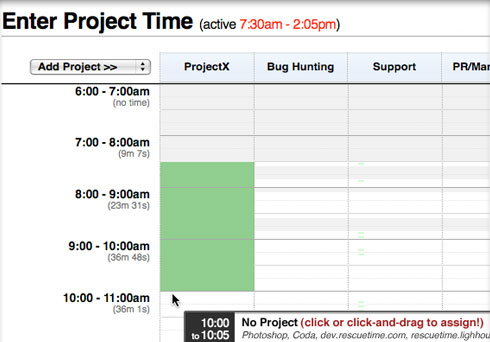- Home
- Blog
- Web Design 9 Productivity Techniques for Freelancers
9 Productivity Techniques for Freelancers
-
 8 min. read
8 min. read
-
 William Craig
William Craig CEO & Co-Founder
CEO & Co-Founder
- President of WebFX. Bill has over 25 years of experience in the Internet marketing industry specializing in SEO, UX, information architecture, marketing automation and more. William’s background in scientific computing and education from Shippensburg and MIT provided the foundation for MarketingCloudFX and other key research and development projects at WebFX.
 Few freelancers work according to the standard eight-hour daily schedule. With remote working opportunities available to almost every designer and home-based offices now a common occurrence, it’s even more difficult to find a designer working to the traditional work schedule than it is to find one enjoying a work style that’s based on nothing more than their own preferences. Experts call it the blurring of work and life, claiming that technology is responsible for integrating work so firmly in our time.
Few freelancers work according to the standard eight-hour daily schedule. With remote working opportunities available to almost every designer and home-based offices now a common occurrence, it’s even more difficult to find a designer working to the traditional work schedule than it is to find one enjoying a work style that’s based on nothing more than their own preferences. Experts call it the blurring of work and life, claiming that technology is responsible for integrating work so firmly in our time.
I think it’s more than that — the result of work schedules that aren’t built around output, but hours spent in the office and projects that simply follow us everywhere. As much as a flexible schedule can be a blessing, it’s an absolute curse when it interferes with our free time. These nine strategies won’t bring you closer to your work; they won’t allow you to check your email from the top of a mountain, and they’re even less likely to help you manage the office from another country. They’ll help you do the opposite: enjoy your time not spent working, create a schedule that doesn’t stick you with endless freelance projects, and design a workweek that puts you in control of your freelance design efforts.
1. Use Time Management Apps
It’s impossible to reduce your work hours without a solid understanding of where they’re going. An all-night design and development session may lead to output and results, but it’s utterly valueless as a piece of data without an understanding of what you spend it doing. Applications like RescueTime let you track your work hours, giving you an understanding of when you work and what you do.
 I like RescueTime for tracking hours and applications and websites I use while being productive — it gives a simple breakdown of the applications that cost you the most time, allowing you to work out which are best blocked. Other useful tools include E.gg Timer and Kukuklok — a simple stopwatch application, and a basic clock for alerting you to finished time blocks and deadlines. Measure and manage — it’s that simple.
I like RescueTime for tracking hours and applications and websites I use while being productive — it gives a simple breakdown of the applications that cost you the most time, allowing you to work out which are best blocked. Other useful tools include E.gg Timer and Kukuklok — a simple stopwatch application, and a basic clock for alerting you to finished time blocks and deadlines. Measure and manage — it’s that simple.
2. Invest in an Office Space
Smart freelancers rarely think of their expenses as wasted money — they think of any spending as an investment in greater productivity, greater visibility, or greater output. Whether it’s money spent on advertising or the latest software, the goal is the same: improving an aspect of their business which would otherwise sit stagnant. Your goal in improving productivity isn’t saving money, but earning more of it.
Serviced offices are like any other business investment — they’re worthwhile when they lead to an increase in output and income. Monitor your average workday output across different workspaces and ensure that you’re always in the best one — it might be worth spending money to reduce distractions. It doesn’t even have to be an office outside of home; you can invest in more equipment or even remodeling work in your home office to make it more conducive to your personal productivity.
3. Remind Yourself to Work While in the Office
Lifehack.org published a guide to home office productivity just over two years ago. While slightly outdated and a little debatable — not all people work better with music, for example — it’s a solid list of ways to improve your productivity at home. Anti-productive distractions and time-wasters are much more common at home, and sometimes it just takes a small change in habits to eliminate them.
But the most important tactic seems to have been missed: remind yourself to work. Some freelancers suggest taping a reminder to the top of your computer screen, while others insist that it’s an internal decision. Whichever strategy you use to remind yourself of looming work deadlines, ensure that it’s something you repeat to yourself whenever distractions begin to appear.
4. Create a Support Team
Sometimes work becomes too much. You’re stressed out, lacking any motivation to continue with your projects, and thoroughly in need of a vacation. After emailing your major clients and letting them know that you’ll be unavailable, you get a last-minute message from someone you’ve worked with before: there’s a task to do, and they need you to complete it straight away.
These situations appear constantly while away from the office, and they’re a sure-fire way to begin worrying about the strength of your connections with clients. Instead of panicking, create a network of other freelancers that can step up and help you in these situations. A quick email to your network can help you preserve client connections, even when out of the office.
5. Take Vacations Regularly
Who says you need a decades-long career to take a sabbatical? Freelancers are in a unique position — not only do they have more freedom than other designers, they’re able to spend time reflecting on their business and working out exactly how they can improve it. I think regular breaks is an essential addition to any freelancer’s business strategy — observing how you work may give you new perspectives on how to improve it.
After your next major project, take a month off to work out how you can make your business less of a liability on your personal time. It often takes less than a week of reflection to realize that what you have now isn’t something that can last for decades. Whether it’s time to develop a new revenue stream or simply a reason to change your approach to clients, a sabbatical can improve your focus.
6. Monitor Your Output
It’s one thing to examine the time you spend working, and another to actively work on improving the way you complete tasks. Tools like RescueTime and E.gg Timer allow you to effectively track hours spent working and applications worked in, but they don’t allow you to record how much of that time lead to real output and measurable results. Record work sessions using two metrics: time spend versus output. Tracking hours alone will lead you to confuse time spent working and the results of that work, while measuring output alone can lead to hours spend working at a dizzying pace.
Record both and you’ll gain an understanding of how you are most effective — something that’s essential for cutting out non-essential work.
7. Practice the Art of Technology Minimization
Next time you’re experiencing a state of productivity that can only be described as “anti-Zen,” ask yourself how you would fare with no technology. Obviously, your computer would remain if you need it to do your work, although it would be almost completely on its own — no internet connection (unless you need it), smartphone, or instant messaging tools would keep it company. As catastrophic as that situation might seem, it’s rarely one that’s unproductive.
The biggest problem for digital workers isn’t a lack of technology or a limit to its ability, but a dilemma caused by having access to too much technology. Sometimes all it takes to become productive is switching your router off and working without the Internet.
8. Automate Your Tasks
There are two types of activities for freelancers: critical activities and non-essential, but somewhat important activities. The first includes major projects and work related to looming deadlines, while the second includes personal finance changes, long-term billing, and replying to email. The first type of activity is more important, but which one do you think costs freelance workers the most time?
Lifehacker, a productivity blog, has attempted to fight back against “crutch” activities for years, going so far as to create a complete checklist of activities that just aren’t that important, yet tend to cost a lot of time. The most common choices for eliminating wasted time are automation or elimination. Make the choice to cut out certain “busywork” activities entirely, or at least automate them to free up more time in your schedule.
9. Be Realistic with Your Work Load
A lot of freelancers are constantly searching for more clients, all under the guise that more business will inevitably lead to more income, more freedom, and more success. There’s no inherent advantage to managing more clients — only a large amount of disadvantages for your work-life balance. The most important metric for any freelancer isn’t the amount of clients you manage or the quantity of projects that you can take on, but their potential to generate income. Expand your business and it will end up requiring more input from you, all for an output that may not scale with growth.
There’s nothing wrong with staying small, especially if it results in a more manageable client base.
Related Content
 Mathew Carpenter is an 18-year-old-business owner and entrepreneur from Sydney, Australia. Mathew is currently working on Sofa Moolah, a website that teaches you how to make money online. Follow Mathew on Twitter: @matcarpenter.
Mathew Carpenter is an 18-year-old-business owner and entrepreneur from Sydney, Australia. Mathew is currently working on Sofa Moolah, a website that teaches you how to make money online. Follow Mathew on Twitter: @matcarpenter.
Follow Sofa Moolah on Twitter: @SofaMoolah.
-
 President of WebFX. Bill has over 25 years of experience in the Internet marketing industry specializing in SEO, UX, information architecture, marketing automation and more. William’s background in scientific computing and education from Shippensburg and MIT provided the foundation for MarketingCloudFX and other key research and development projects at WebFX.
President of WebFX. Bill has over 25 years of experience in the Internet marketing industry specializing in SEO, UX, information architecture, marketing automation and more. William’s background in scientific computing and education from Shippensburg and MIT provided the foundation for MarketingCloudFX and other key research and development projects at WebFX. -

WebFX is a full-service marketing agency with 1,100+ client reviews and a 4.9-star rating on Clutch! Find out how our expert team and revenue-accelerating tech can drive results for you! Learn more
Make estimating web design costs easy
Website design costs can be tricky to nail down. Get an instant estimate for a custom web design with our free website design cost calculator!
Try Our Free Web Design Cost Calculator


Web Design Calculator
Use our free tool to get a free, instant quote in under 60 seconds.
View Web Design CalculatorMake estimating web design costs easy
Website design costs can be tricky to nail down. Get an instant estimate for a custom web design with our free website design cost calculator!
Try Our Free Web Design Cost Calculator




